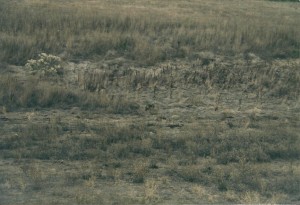For nearly 15 years, I lived in the Upper Ojai Valley, our house perched at the edge of a vast field, offering our family a daily panorama of the changing weather, the changing seasons, and a constant diorama of wildlife doing what wildlife does. Besides the regular stream of birds, the fields were the daily hunting ground for coyotes. Camouflaged to blend with the chaparral of the hillsides, the coyotes spent their days feasting on the multitudes of ground squirrels which proliferated in our walnut groves. As far as I could tell, they seemed to spend their nights having loud sex.
One would have to relax his eyes to see them, as there would be a slight movement in the grass and suddenly you would realize that you are looking at an entire family/pack of them. As we were living on a school campus, it seemed like every resident had one or two domestic dogs, some of them quite sizable. The campus dogs would also travel in packs, happily spending their hours poking down holes, digging new holes, or lining up behind the commons after meals to beg scraps. What they lacked in wisdom, the campus dogs made up in enthusiasm. Thus they would race off into the fields at the first sight of a coyote only to find that the local had brought several friends with him. Thus would begin the regular face-offs in the field, where the campus dogs would sidle forward in a pack and the coyotes would stand their ground. If the domestics suddenly charged forward, the coyotes would disperse broadly, but only back up a little. If the domestics began to retreat, the coyotes would generally send one member forward to do a sort of canine “nyanananana”, which would get the domestics going again. This might go on for an hour. Both teams seemed to greatly enjoy this game and we never knew it to create casualties. For one thing, the coyotes were at least twice as fast as any campus dog. (In the rare times that we saw one coyote chasing another, we would be astounded at their remarkable speed.)
Now, if it was just one or two dogs that were coming across the field, the coyotes adopted a whole new strategy. One, usually a female, would bark and false charge, keeping the attention of the oncoming dog, while two or three others would triangulate around behind. At this point, I would always call my dogs, as once any animal is locked into that triangle, the odds are against him. We would, of course, see many coyotes while walking the land, but they were never a concern, as long as they stayed on one side of you. If one began to bark at you, it was always a good idea to look over your shoulder. Of course, this was also the reason that most campus dogs were big. What they lacked in savvy or speed, they made up for in pure bulk. Our one sad casualty was poor little Maxine, a teacup poodle that arrived with Meredy and the kids and managed to live for several years. She was good at keeping close to the house (as were the cats with survival instincts) but late one night coming home with Meredy, she hopped out of the car and was immediately swept up by a waiting coyote who made it about 100 yards before our giant dog, Bilko, convinced it to abandon her kill, but it was too late for Maxine who now lies buried nearby.
On a lighter note, there was the year that one of our maintenance guys, Tom, decided to raise chickens in and around the barn. My memory says that he had about 150 at his high point. One could sit in our living room in the evening and watch the coyotes filing across the field like the line at In and Out Burger, all purposefully plodding in the direction of the barn. It was not uncommon to see a few trotting the other way with a plump poultry in their mouths. A similar fate was met by the ducks that Karen and Dave tried to raise. This year must live in legend if there is actually folklore among the coyotes, perhaps known as The Year of Plenty or The Year of The Feathery Fat Things That Are Dumber and Slower Than Squirrels.
As most people appreciate a nice illustration with an article, the accompanying picture, shot from our living room, has three coyotes in it. Just think of it as Where’s Waldo for wildlife.
I have to say I miss the coyotes, as I miss the changing seasons of that land. While we now live in town, we are at the edge of the Los Padres National Forest and we can sit on the patio most evenings and listen to the coyotes just up the hill whooping it up over whatever be their current enthusiasm. But I have never seen one on our street. Perhaps if we raised chickens….


